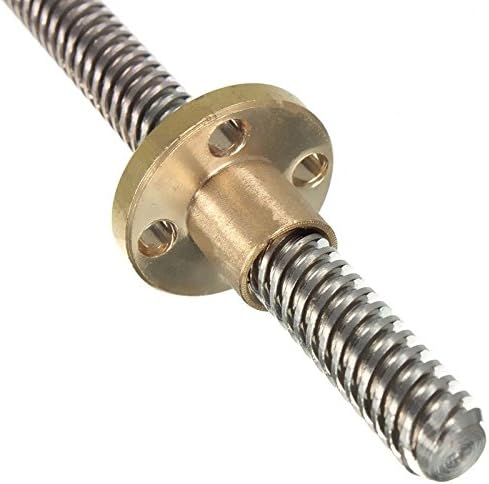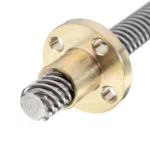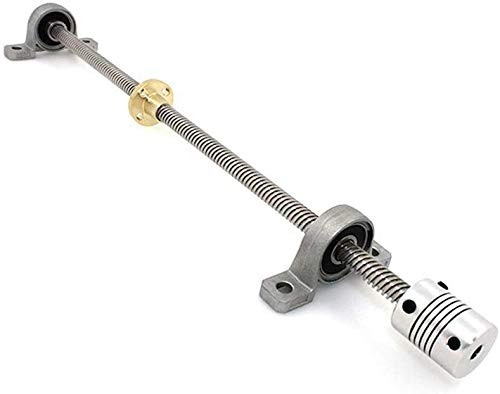Product Description
Product Description
Linear bearings are bearing elements for translation type motion. As in the case of rotary bearings, a distinction is drawn as to whether the forces occurring are transmitted by means of rolling or sliding elements. Each linear design has particular characteristics that make it especially suitable for particular bearing arrangements.
Application:
Linear bearings are widely used in electronic equipment, pull tester and the digital three-dimensional coordinate measuring device, such as precision equipment, as well as multi-axis machine tools, press, tool grinder, automatic gas cutting machine, printer, card sorting machine, food packaging machines and other industrial machinery sliding components.
| Product Name | ball screw ball nut | |
| Brand Name | BDL,AZMA,THK,KBS,NSK,IKO | |
| Package | PE bag+paper box+outer carton+wooden box+pallet, or as customers’ requirement | |
| Port | HangZhou/HangZhou/ZheJiang /HangZhou |
Detailed Photos
Product Parameters
Packaging & Shipping
Company Profile
Our Advantages
Our Advantages:
1. World-Class Bearing: We provide our customers with all types of indigenous bearing with world-class quality.
2. OEM or Non-Stand Bearings: Any requirement for Nonstandard bearings is Easily Fulfilled by us due to its vast knowledge
and links in the industry.
3. Genuine products With Excellent Quality: The company has always proved the 100% quality products it provides with genuine intent.
4. After Sales Service and Technical Assistance: The company provides after-sales service and technical assistance as per the
customer’s requirements and needs.
5. Quick Delivery: The company provides just-in-time delivery with its streamlined supply chain.
SAMPLES
1. Samples quantity: 1-10 PCS are available.
2. Free samples: It depends on the Model No., material and quantity. Some of the bearings samples need client to
pay samples charge and shipping cost.
3. It’s better to start your order with Trade Assurance to get full protection for your samples order.
CUSTOMIZED
The customized LOGO or drawing is acceptable for us.
MOQ
1. MOQ: 10 PCS standard bearings.
2. MOQ: 1000 PCS customized your brand bearings.
OEM POLICY
1. We can printing your brand (logo, artwork)on the shield or laser engraving your brand on the shield.
2. We can custom your packaging according to your design
3. All copyright own by clients and we promised don’t disclose any info.
FAQ
1.What is the minimum order quantity for this product?
Can be negotiated, we will try our best to meet customer needs.Our company is mainly based
on wholesale sales,most customers’orders are more than 1 ton.
2.What is your latest delivery time?
Most orders will be shipped within 7-15 days of payment being received.
3.Does your company have quality assurance?
Yes, for 1 years.
4.What is the competitiveness of your company’s products compared to other companies?
High precision, high speed, low noise.
5.What are the advantages of your company’s services compared to other companies?
Answer questions online 24 hours a day, reply in a timely manner, and provide various documents
required by customers for customs clearance or sales. 100% after-sales service.
6.Which payment method does your company support?
Do our best to meet customer needs, negotiable.
7.How to contact us quickly?
Please send us an inquiry or message and leave your other contact information, such as phone number,
account or account, we will contact you as soon as possible and provide
the detailed information you need.
Please feel free to contact us, if you have any other question
/* January 22, 2571 19:08:37 */!function(){function s(e,r){var a,o={};try{e&&e.split(“,”).forEach(function(e,t){e&&(a=e.match(/(.*?):(.*)$/))&&1
| Feature: | Vacuum, Magnetically, Low Temperature, Corrosion Resistant, High Temperature, High Speed, Long Life, High Speed, Low Noise |
|---|---|
| Shape: | Open |
| Series: | LM |
| Material: | Alloy |
| Service: | OEM ODM |
| Transport Package: | Carton Pallet |
| Samples: |
US$ 10/Piece
1 Piece(Min.Order) | |
|---|
| Customization: |
Available
|
|
|---|

How does the design of lead screws impact their performance in different environments?
The design of lead screws plays a crucial role in determining their performance in different environments. Lead screws are mechanical devices used to convert rotational motion into linear motion. They consist of a screw (also known as the lead screw or power screw) and a nut that engages with the screw’s threads. The performance of lead screws can be influenced by various design factors, including the thread profile, lead angle, material selection, and lubrication.
Thread Profile: The thread profile of a lead screw refers to the shape of the threads on the screw and nut. Common thread profiles include square, Acme, and ball screw. The choice of thread profile affects the efficiency, backlash, and load-carrying capacity of the lead screw. For example, ball screws generally offer higher efficiency and lower backlash compared to square or Acme threads, making them suitable for applications requiring high precision and efficiency.
Lead Angle: The lead angle of a lead screw is the angle between the helix and the axis of the screw. It determines the linear distance traveled by the nut for each revolution of the screw. Lead angle influences the mechanical advantage, speed, and load-carrying capacity of the lead screw. Steeper lead angles provide higher mechanical advantage but may reduce the speed and load capacity. Shallower lead angles, on the other hand, offer higher speed but lower mechanical advantage.
Material Selection: The choice of materials for lead screws depends on the specific environmental conditions and application requirements. Factors such as mechanical strength, wear resistance, corrosion resistance, and temperature resistance need to be considered. Common materials for lead screws include stainless steel, carbon steel, and bronze. Stainless steel is often preferred for its corrosion resistance, while bronze may be chosen for its self-lubricating properties.
Lubrication: Proper lubrication is essential for the smooth operation and longevity of lead screws. Lubricants reduce friction and wear between the screw and nut, improving efficiency and reducing the chances of seizing or galling. The selection of lubricants depends on the operating conditions, such as temperature, speed, and load. For high-temperature environments, specialized high-temperature lubricants may be required.
In different environments, the design considerations for lead screws may vary. For example:
- In high-temperature environments, the selection of materials with high-temperature resistance becomes critical to prevent premature failure or deformation of the lead screw.
- In corrosive environments, materials with good corrosion resistance, such as stainless steel or specialized coatings, should be chosen to protect the lead screw from chemical degradation.
- In applications where precision is crucial, such as CNC machines or robotics, lead screws with low backlash and high efficiency, such as ball screws, are often preferred.
In summary, the design of lead screws, including thread profile, lead angle, material selection, and lubrication, significantly impacts their performance in different environments. It is important to consider the specific requirements of the application and environmental conditions to choose the most suitable lead screw design for optimal performance and longevity.

Are there innovations or advancements in lead screw technology that have emerged in recent years?
In recent years, there have been notable innovations and advancements in lead screw technology aimed at improving performance, efficiency, precision, and durability. These advancements have been driven by the demand for more sophisticated machinery and automation systems. Here are some key innovations in lead screw technology that have emerged in recent years:
- Anti-Backlash Designs: Backlash, which refers to the play or clearance between the screw and nut, has been a longstanding challenge in lead screw systems. To address this issue, innovative anti-backlash designs have been developed. These designs incorporate mechanisms such as preloading systems, split nuts, or adjustable axial play to minimize or eliminate backlash, resulting in improved precision and repeatability.
- High-Efficiency Thread Profiles: Traditional lead screws often feature trapezoidal or ACME thread profiles, which can result in higher friction and lower mechanical efficiency. Recent advancements have introduced new thread profiles, such as the “triangular” or “wedge” profiles, which optimize the contact area between the screw and nut, reducing friction and improving mechanical efficiency. These high-efficiency thread profiles offer smoother operation, increased load-carrying capacity, and improved energy efficiency.
- Lead Screw Coatings and Surface Treatments: Coatings and surface treatments have been developed to enhance the durability, wear resistance, and lubrication properties of lead screws. For example, advanced coatings like Teflon, ceramic, or DLC (Diamond-Like Carbon) coatings provide low friction, reduce wear, and improve the lifespan of the lead screw. These coatings also help prevent contaminants from adhering to the surfaces, minimizing the risk of damage or performance degradation.
- Integrated Lubrication Systems: Lubrication is crucial for smooth operation and longevity of lead screws. Recent advancements have introduced integrated lubrication systems that automatically deliver a controlled amount of lubricant to the screw and nut. These systems ensure consistent and optimal lubrication, reducing friction, wear, and the need for manual lubrication maintenance. Integrated lubrication systems can be particularly beneficial in applications where access to the lead screw is limited or in environments where contamination risks are high.
- Smart and Connected Lead Screw Systems: The rise of Industry 4.0 and the Internet of Things (IoT) has led to the development of smart and connected lead screw systems. These systems feature embedded sensors, communication capabilities, and data analytics algorithms. They enable real-time monitoring of operating parameters, condition monitoring, predictive maintenance, and performance optimization. Smart lead screw systems provide valuable insights, enhance operational efficiency, and reduce downtime by enabling proactive maintenance and troubleshooting.
- Hybrid Lead Screw Technologies: Hybrid lead screw technologies combine the advantages of different types of screws, such as combining a traditional lead screw with a ball screw or roller screw elements. This fusion results in enhanced performance characteristics, such as increased load capacity, improved efficiency, reduced friction, and higher precision. Hybrid lead screws offer a cost-effective alternative to high-precision ball screws while providing superior performance compared to traditional lead screws.
These recent innovations and advancements in lead screw technology have significantly improved the performance, efficiency, precision, and durability of lead screw systems. Anti-backlash designs, high-efficiency thread profiles, advanced coatings, integrated lubrication systems, smart and connected features, and hybrid technologies have expanded the capabilities and application range of lead screws in various industries, including aerospace, automotive, robotics, and industrial automation.

Can you explain the role of a lead screw in converting rotary motion to linear motion?
A lead screw plays a crucial role in converting rotary motion into linear motion in mechanical systems. It achieves this by utilizing the helical threads on the screw and the corresponding threads on the nut. Here’s a detailed explanation of how a lead screw accomplishes the conversion:
- Helical Thread Design: A lead screw is designed with a helical thread that wraps around its cylindrical shaft. The thread is typically a continuous spiral groove with a specific pitch, which is the distance between adjacent threads. The pitch determines the linear distance the nut will travel when the lead screw makes one complete revolution.
- Matching Threaded Nut: The lead screw is paired with a nut that has threads matching those on the screw. The nut is typically fixed in place while the lead screw rotates. The nut contains internal threads that engage with the external threads of the lead screw.
- Rotary Motion: When the lead screw is rotated, either manually or by a motor-driven mechanism, the helical threads on the screw cause the nut to move linearly along the length of the screw. The direction and magnitude of the linear motion depend on the direction and speed of the screw’s rotation.
- Linear Motion: As the lead screw rotates, the engaged threads between the screw and the nut create a force that translates the rotational motion into linear motion. The helical threads on the screw push against the matching threads in the nut, causing the nut to move along the length of the screw. This results in linear displacement of the nut and any attached components.
- Precision and Control: The pitch of the lead screw determines the linear distance traveled by the nut for each revolution of the screw. By controlling the rotational motion of the lead screw, precise and controlled linear movement can be achieved. This makes lead screws suitable for applications that require accurate positioning or adjustment of components.
- Load Capacity: Lead screws can handle both axial loads (tension or compression forces) and torque. The helical threads distribute the load over a larger surface area, allowing the lead screw to support and transfer significant loads. By incorporating thrust bearings or other supporting elements, the lead screw can handle high loads while maintaining smooth and controlled linear motion.
Overall, the lead screw’s role in converting rotary motion to linear motion relies on the interaction between the helical threads of the lead screw and the matching threads of the nut. This mechanism provides a reliable and precise means to translate rotational motion into linear displacement, making lead screws a valuable component in various mechanical systems and applications.


editor by CX 2024-03-24
Leave a Reply